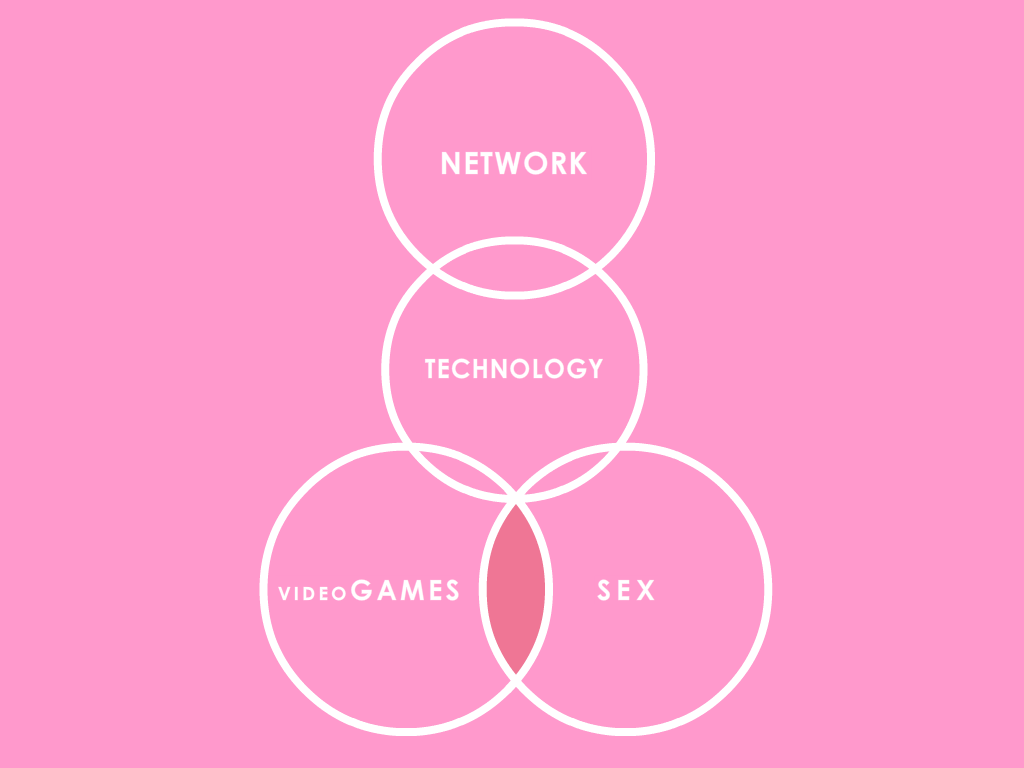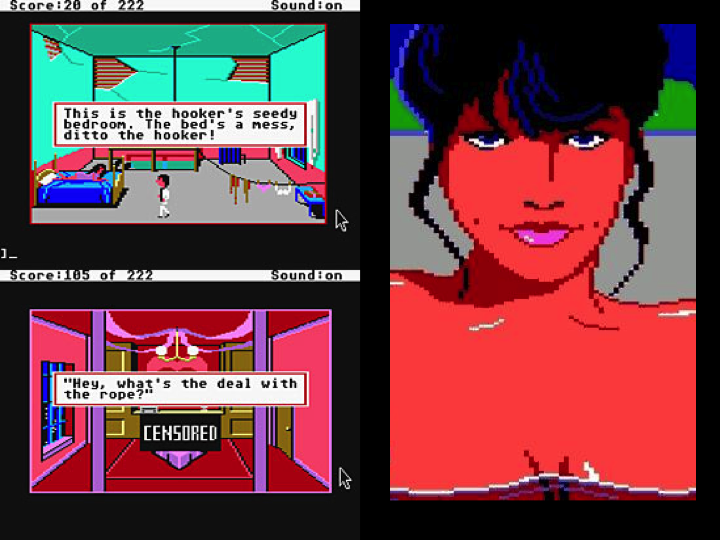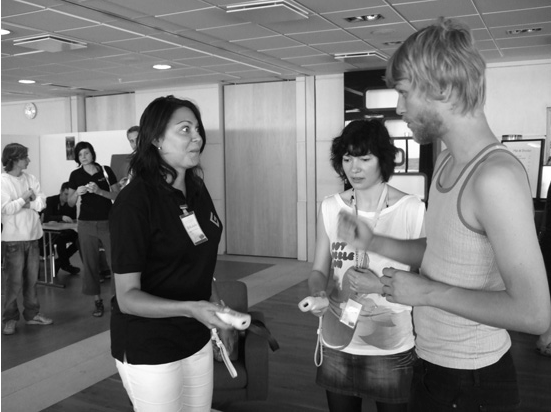Arse Elekronika (not to be confused with the similarly sounding, slightly more established new media art festival in Linz) is the most important conference investigating the intersection of sex and technology. The past six editions revolved around themes like porn as innovation driver, sexuality in science fiction or body enhancements. This year the emphasis was on games and the three day festival included performances, workshops, and an eclectic mix of lectures: from the challenges of simulating sexual intercourse in Nordic LARPs to the dating strategies among volunteers in disaster zones, from the physics of vibrators and sex machines to the auto-ethnography of masturbation…
My talk simply dealt with the procedural representation of sex in videogames. I publish the presentation here, along with most of the images and videos I screened. The text is a transcript quickly adjusted to the written form so forgive me for the colloquial style, the repetitions and the wonky grammar.
Summary
What is the role of sex in the functionalist worlds of videogames? How come that modeling intercourses through cybernetic systems seems only to produce hilarious, problematic and delightfully reductionist outcomes?
In this gonzo survey of playable coitus, I descend from the prudish polish of AAA games to the subappreciated subterranean genre of interactive pornography (so you don’t have to) and then re-emerge to envision alternative design approaches for healthy, sex-positive, post-pornographic, radical games.
Let me start with a premise.
Sometimes there’s is a bit of confusion in popular culture when we come to the subject of sex and games because videogames are still seen as technological objects. Everything that uses game-related technologies ends up in the same realm of gaming. For example immersive environments.
Second Life is often presented as a game because it looks like a game. But in fact it’s a virtual community. There is a lot of experimentation with desire there, but I’d argue that the sex happening in Second Life is just a more sophisticated version of the good old cybersex via text or of the early MUDs.
The issues of erotic roleplaying, gender bending, virtual BDSM, romance in online communities have been studied a lot since the 90s.
So that’s not what I’m going to talk about today.
Other game technologies that are often associated with sex & gaming are the interfaces. Videogames have always been pioneering new forms of human-computer interaction, looking for richer and novel experiences.
The results, not surprisingly, have been hacked into technologies of pleasure. Using the Rez trance interface as sex toy or hooking up game interfaces to control vibrators…
And there’s the whole exploration of the joystick as a phallic symbol (i.e. Swordfight by Kurt Bieg and Ramsey Nasser, Joydick by Randy Sarafan).

However, formally speaking, a videogame is not an assemblage of technologies.
Videogames are just the digital incarnation of a cultural form older than history.
Games are primarily systems of rules.
They can be social interfaces.
Protocols for human-to-human interaction.
They can be expressive media, as they create representations through their own language.
More often than not they propose questionable representations, embracing and reinforcing the dominant systems of value.
With this important distinction in mind and from the point of view of a game maker. I’ve been trying to figure out in what ways sex and videogames intersect, trying to come up with a tentative taxonomy.
Sex as Reward
I’m talking about erotic content as a form of reward for reaching certain goals.
This use is exemplified by the infamous Atari game Custer’s Revenge.
[youtube _AmQSQI60Wo 800 600]
(The player takes the role of Custer, traverses the screen avoiding falling arrows in order to rape the Indian princess on the right)
Sex-as-reward appears more subtly in the “princess in distress” trope in games like Super Mario.
Should we assume than saving princesses is just for chivalry?
Isn’t is more likely that working-class-hero Mario is trying to climb his way up to aristocracy?
If so there’s probably sex involved.

It’s been said that a lot of action games cater to the primal hunter-gatherer wiring of our brains. Especially regarding the prominence of shooting, chasing/escaping, and accumulating items.
I’d argue that the trope of sex as reward derives from something even more primal, straight from our distant primate past.
In patriarchal primate societies hierarchy is strictly connected to the ability to reproduce. Typically, the alpha male is the individual who gets the first pick in mate selection.
I think a lot of game structures resonate with the desire of conquering alpha male status.
More abstract instances of Sex as reward are present in the many erotic variants of arcade games. Like digital strip poker or the Gals Panic series.
[youtube kNe_8fxKFvk 800 600]
Gals Panic creates an interesting tension between gameplay and content: you can’t really ogle at the semi-naked “gals” because you have to focus on your purely mechanical goal. The reward here is also a distraction.
Dating sims, especially the hentai type present sex as reward in the most direct way.
Dating sims are mostly produced and played in Japan. In the West, the closest thing we have is the Leisure Suit Larry series which is way tamer, there’s more gameplay and humor.
Larry’s games are basically graphic adventures in which you are a dorky, awkward middle aged guy trying to to seduce women by solving puzzles and by having conversation with them.
In contrast the subculture of hentai dating games can be quite extreme. Touching upon rape fantasies, mild incest and so on.
In this one, called “Hypnosis class”, you have the power to hypnotize young girls and make them do headstands.
In these games dating, foreplay, and sometimes intercourse are implemented as a puzzle.
You have multiple choices and you have to say and do the right things to impress a girl (in a less popular subgenre, the gender roles are inverted). Only some of the choices lead to a positive outcome.
I think it’s interesting that this genre is coming from a country where dating culture seems to be broken. Unmarried people are on the rise and population is in decline. The government is funding speed dating events
and courses for personal relationship.
You can see this genre as a manifestation of a broader discomfort, games like all cultural artifacts reflect their social context. After all, in the West we have a plethora of games about shooting Arabs.
However, I don’t think this kind of dating game, this idea of seduction as puzzle contributes to a relaxed, uninhibited view of personal relationships.
Sex a plot device
The second category is what I call sex as plot element or plot device. Relatively common in story-based games, sometimes this aspect overlaps with sex as reward.
In the sense that sex scenes can be a reward for tolerating bad voice acting and uncanny 3D puppets.
[youtube 4cIS0xcNDhQ 800 600]
Sex as plot device is not extremely interesting to me because is not too different from what you see in non-interactive narrative forms. The sexual intercourse overt or implied is there to establish a certain relationship between characters.
When the intercourse is presented as a non interactive cut scene in games, it generally follows standard Hollywood conventions: elliptical montage, sweeping music and dim light to signal tastefulness.
Often it happens with underwear on, to dodge full frontal nudity and adult ratings.
As you see there’s a quite lot of diversity: woman on woman (although always femme), gay elves… The mass effect series pretty much explored all the combinations of humanoid alien on human sex.
[youtube 1ySbXyK9d9c 800 600]
But we’ve seen all of this in Avatar already.
Things get more interesting when you have interactive sex scenes because they are more specific of the gaming language.
This chapter in Heavy Rain is at the threshold between interactive and non interactive.
[youtube VYX4tjXB7Ow 800 600]
It starts with a cinematic dialog and direction. And then it switches to awkward quicktime action foreplay.
The bra is like the final boss. If you don’t unhook it, she keeps it on while making love.
Then, when the foreplay becomes sex, the game switches back to non-interactive.
I think it’s a good expressive choice. You have this initial awkwardness and hesitation, there’s the possibility of failure or rejection (consider that at this point of the game the two characters are strangers to each other) but then, when you melt the ice, you just go with the flow, like in autopilot.
This scene takes me to the third big category, which is the most game specific and worth analysis.
Sex as Mechanic
When sex is interactive and integrated in the gameplay some issues arise. I’m not talking about moral issues and decency (who cares?) but about how sexuality is represented through a computational medium.
We use the catchphrase “the medium is the message” to talk about how the properties of a medium affect the content.
In film and video-based porn the presence of a camera informs the mechanics of the intercourse.
Certain positions are privileged because they work well on the screen. The scene is always well lit. External ejaculation is common because is more spectacular and so on…
So what about video games? How do they affect the representation of sex?
Function
For starters, gaming worlds are designed around goals. Pretty much everything in a game is functional or detrimental to the player’s success. So it’s no surprise that sex always struggled to find a place in games. Non reproductive sex is a rather useless activity, it is supposed to be an end by itself.
[youtube V1d9EeD8ntA 800 600]
Grand Theft Auto S. Andreas contained an hidden sex mode that created a lot of controversies when players figure out how to unlock it. But it was an easter egg buried in the code, not a necessary component. You don’t really need romance to be a successful gangster.
The mechanic is a sort to rhythm game: you have to push a couple of buttons rhythmically. That’s how sex is often implemented in games.
In more recent episodes (GTA IV) sex is more integrated in the overall gameplay although it’s not as explicit nor interactive.
[youtube k7HFAbCGEpQ 800 600]
Having sex affects the stats of your character. It gives you energy like a sandwich. Needless to say there’s no psychological well being bar to keep in balance.
Formally speaking it’s a Money for energy transaction. It’s less labor intensive with prostitutes because proper girlfriends need to be seduced, you have to take them out on a date, give them presents and so on.
Quantities
In computational media everything is expressed by numeric values and mathematical formulas, so there is a natural bias toward representing things that can be quantified.
Sure, you can do sexy things with numbers but when you translate the continuous unmeasurable events of our world into a set of measurable entities you are adopting a very reductionist process.
In GTA hot coffee you have an “excitement” bar. In Indigo prophecy a.k.a. Fahrenheit there is another seminal interactive sex section.
[youtube Xd0X4kGfVKg 800 600]
And you can see relationship stats floating around on the interface.
During sex you have a bar that represent the thrust: the complexity of two intimate bodies is abstracted in one penetration variable. Instead of a two-way flow of information with the girl you basically have a “correct” way to fuck.
Back in 2003, when I started making games, I tried to explore what I called awkward roleplaying. It consists in forcing the player into disempowered, embarrassing, unusual roles. Reversing the tendency of mainstream games to function as power fantasies in order to push the player to reflect on power relations that exist in the real world.
[youtube YQT2faegkhk 800 600]
Orgasm Simulator the quantification of sexuality and the cybernetic reductionism is used in an ironic way.
Eros is protagonist In Playboy: the mansion and quantification is rampant because it’s essentially a resource management game with a lot of variables.
[youtube JvVYOl88UhI 800 600]
Playboy: the mansion is a crossover between a business game and life simulation game like the Sims. You are Hugh Hefner and you have to manage the Playboy Magazine. You do so mostly by throwing parties, keeping good relationship with pin-ups and making connections with writers.
It’s an ambitious title because it tries to simulate a business centered on relationships rather than physical commodities. From this perspective, Playboy is a great simulation of knowledge capitalism. Friendship, affects, reputation as well as primal instincts are subsumed under the Capital, they are quantified, exchanged and – as we Marxist like to say – they are put to work.
Compute this
Now, I don’t mean to blame the designers entirely for these cybernetic biases. Computer games, like all media, are not infinitely malleable.

Technologies have a history crystallized in their “DNA”. The first computing machines were invented to calculate the bombs trajectories.
So the history of computer games is mostly a history of ballistic, a history of newtonian materialism. It’s a history of objects moving in space and clashing with each other.
[youtube _QXR529z8lU 800 600]
There are still serious technical limits in the representation of rounded, soft bodies.
It’s a major aspect of the Uncanny Valley. The promise of photographic realism is only partially delivered.
We created technologies that make the simulation of a grenade launcher way easier than a caress.
Interfaces
Another technological challenged is posed by the interfaces. Reality has infinite affordances – there are infinite ways to grab a cock – but human computer interaction happens through very limited protocols.
This explains the misery of “quicktime events” sections like the one in Heavy Rain. Standard game controllers are designed to perform simple spatial movements (directional keys, analog sticks) and instantaneous actions (buttons as digital switches).
Game makers have to be very literal about what to do when you have situations that are not codified in gaming language (press this button to kiss on the neck)
The God of War series solves this problem cleverly using ellipsis and over the top humor.
[youtube mjvO1p-v4ZU 800 600]
7 Sins, a casanova simulator, employs imaginative minigames.
The gamification of the Male Gaze…
[youtube SnTlwVd3-gg 800 600]
Mapping the female body on a game controller…
[youtube jCi5JImoER8 800 600]
These examples show the limits of standard game controllers when applied to intimacy.
But the increasingly popular touch screen technologies could provide a less awkward way to deal with interactive eroticism. They are not centered around the control of objects in space, and they employ the sense of touch in a more “literal” way.
Feel the Magic XY/XX is one of the earlier games released for Nintendo DS (the gaming platform that popularized touch screen). It strategically explored the new affordances of the interface through mini-games and established a new sensual relationship with the device. The game revolves around seducing a elusive girl and competing with other male contenders in a series of short, surreal challenges.
It also features a rather disturbing harassment mode, in which you can design the object of your desire and touch, poke, caress her despite her overt resistance.
[youtube szRPO0d_2ZQ 800 600]
On the opposite end of the spectrum there is Lapis[http://www.moboid.com/lapis/LapisPres.htm], a concept game for DS conceived by Heather Kelley during a sex-themed design challenge. Lapis is presented as a (self)educational tool to explore female sexual pleasure. The erogenous zones are metaphorically represented by bunnies – reminiscent of virtual pets – whom the player “stimulate” by stroking, scratching tickling etc. The bunnies have different patterns of pleasure representing the variety of female sexual respose.
The gestural interfaces of the latest generation like the Wiimote, the Kinect or the Playstation Move allow for even more affordances, engaging the whole body of the players, ideally transcending the symbolic nature of the gamic action (right key = run right).
However, when the gesture becomes too literal it opens a new world of awkwardness. While a Kinect Kamasutra is still nothing more than a running joke among gamers, the party game We Dare for Nintendo Wii and Playstation 3 faced widespread derision upon its European launch, pushing the publisher to cancel further releases.
The mini-games in We Dare are meant to facilitate intimate contacts among players, most notably spanking, and making out with the game controllers.
The Dark Room Sex Game by the Copenhagen Game Collective intentionally exploits the awkwardness of gestural interfaces by mimicking an abstract intercourse among two (or more) players. With only audio as feedback, the players shake the controllers rhythmically, negotiating the crescendo until they reach the climax.
Interactive Porn
The last category I have to mention pertains to the “use” of the artifact itself. Can games be jerk-off material? Can games be the/a future of porn?
Some companies believe so, and they produced some unique media objects.
In what I call interactive porn for lack of better names, sex is not inscribed in a goal oriented gameplay or in a plot because its representation is the game’s only purpose.
These games are more properly software toys or, as some game people say, paideia that are non-competitive, freeform kind of games.
The most sophisticated examples of this obscure genre are the products from 3d Sexvilla line, produced by an Austrian company called Thrixxx.
[youtube olDcsBL_82w 800 600]
If film/video porn revolves around contemplation and identification, interactive pornography shifts the focus toward control and customization.
By removing goals, you also remove the negotiation with the partner (real of virtual) and the climatic action. The intercourse last as long as the user want.
You have these non player-controlled characters that seems unable to reach the orgasm and express the same degree of pleasure over time.
They are fucking machines fucking other fucking machines.
Virtual porn heavily relies on customization. It’s a stage to enact your fantasies, especially if your fantasy is to be a porn director.
[youtube Mf38ywIJXeo 800 600]
In 3d Sexvilla 2, the level of customization is remarkable. You have a dozen of parameters just for defining the models’ eye make up. You have positions, scenarios, toys and props. New content is available as in game purchase, that’s how the industry works now.
And yet, the range of possible outputs are extremely normative. You can’t do male on male unless you purchase the specifically gay title. You can’t grow a penis on a female body. Women can only be femme and characters have a fairly narrow range of body shapes.
[youtube nvZHk0vcBH8 800 600]
And obviously, computer graphics itself can be hyper-normative. It proposes unattainable models of beauty, impossibly smooth skin, unlikely physics and supernatural performances. If the photoshopped beauty in glossy magazines and the aesthetic canons of mainstream pornography are a reason for concern, the prospect of a proliferation of CGI models in media is even more problematic.
This is such a missed opportunity. We have this medium that can really push the boundaries of what it is imaginable and fuckable, and we constrain it within the rigid barriers of mainstream porn.
Even the family-friendly evolution game Spores, when properly mis-used, can produce more interesting results:
[youtube FeZcRPndCj4 800 600]
Now this creatures may not be sexy but they are a demonstration of the variety of forms that can emerge from a computational environment.
Queer Power is another game I made in 2004, also dealing with the limits of roleplay and identification in videogames.
I just got into Judith Butler’s Queer Theory and I was like: these ideas are so powerful, so necessary, so disruptive for both queers and straights, but all the gender studies literature is so inaccessible and self-referential. So I decided to make a little game inspired by it.
Queer power is set in another planet populated by creatures without fixed gender roles. At the beginning you can express a general preference for certain genitalia, but during the game you can shape-shift between 4 different positions/genders.
[youtube 6-jeViv_iBA 800 600]
The game itself is a reversal of the 2D fighting genre. You have a typical layout but instead of fighting you enact a strange intercourse, instead of energy bars you have pleasure bars.
The amount of pleasure you give and get depends on you initial preference and on the current status of the other player. So playing is a constant negotiation between your desire the other entity’s desire and state.
There is a conclusion, the orgasm, but no imposed goal. Players can compete to see who comes first or who lasts longer. Or they can try reach the orgasm at the same time.
Pushing the limits of roleplay is just one of the many things that videogames can do.
There are very few videogames that function as social interfaces for people in proximity.
Beside the failed experiment of We Dare and the humorous experiment of Dark Room Sex Game, few game makers attempted to explore or mediate intimacy between players.
[youtube VaUfqztfYcM 800 600]
Fingle, is a 2 player iPad game produced by a small Dutch studio called Game Oven.
You can think of it as a Twister for fingers. Two players, operating on the same tablet, have to follow increasingly complex patterns with their fingers. The presentation is completely abstract and the erotic undertones are just hinted at by the ’70s-inspired art.
I think Fingle could be a step in a new direction. A new category in my tentative taxonomy.
Why can’t games be initiator of contacts between real bodies?
Why can’t they be part of a date or foreplay like a romantic movie or a nice dinner?
Instead of awkwardly surrogating a sexual partner, games can be social interfaces between real people. Like Jaakko Stenros suggested yesterday regarding Nordic LARPs, they can be an alibi for doing things you wouldn’t otherwise do.
There can be videogames that allow us to experiment with desire and gender performance.
We just have to design them.

















